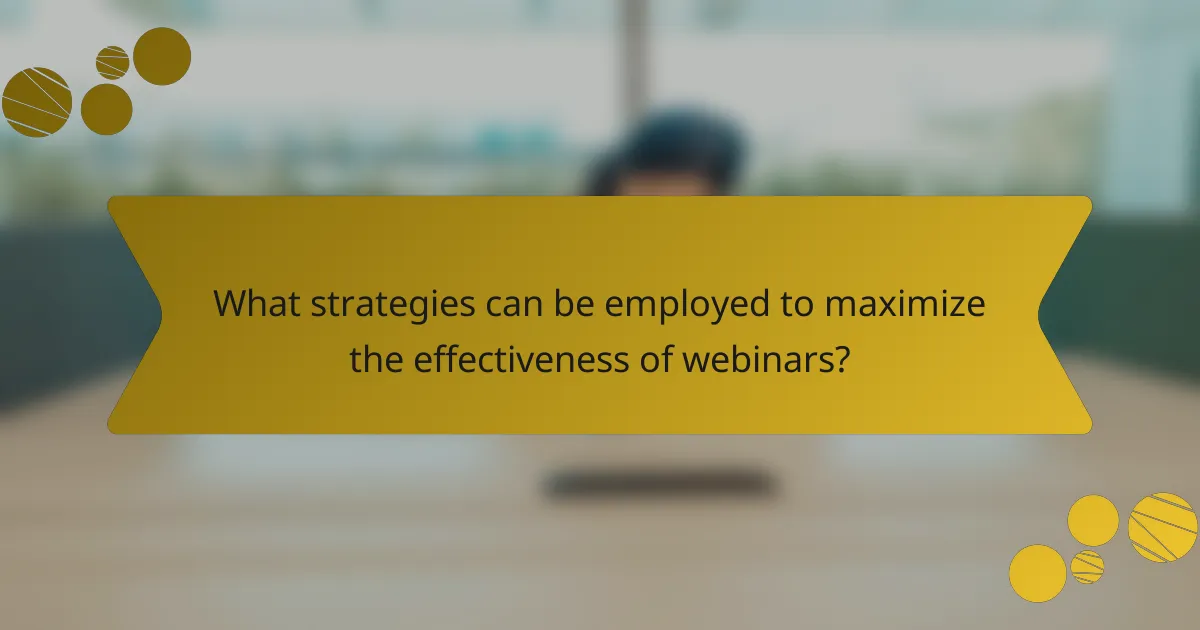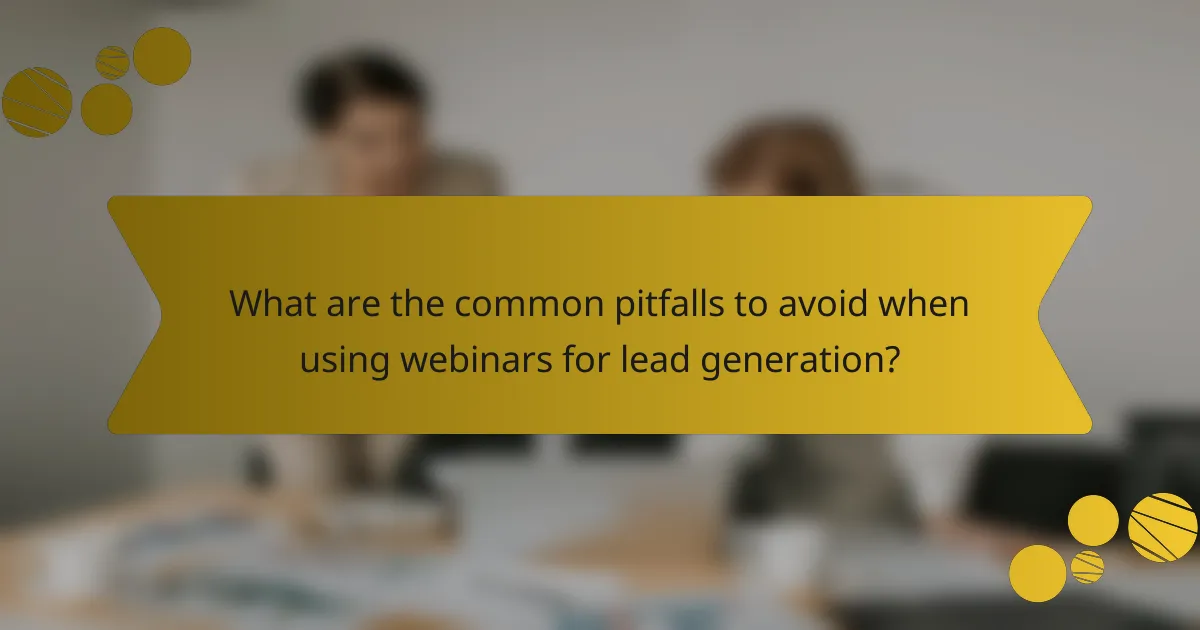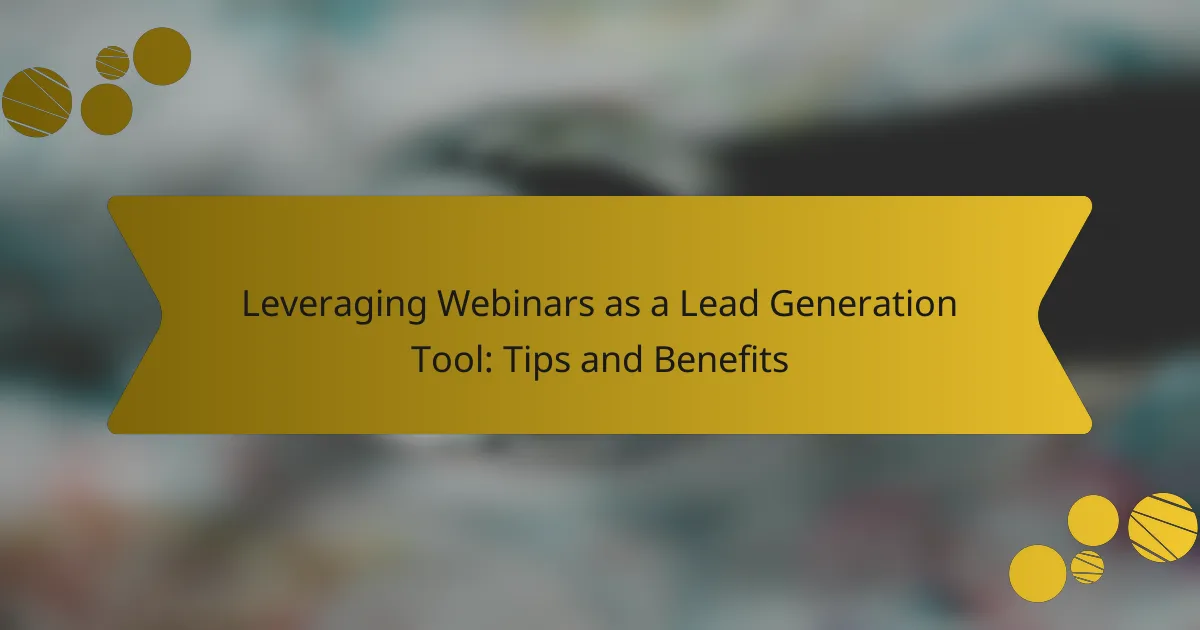Webinars are interactive online seminars that can be live or recorded, serving as a powerful tool for lead generation. They allow businesses to present knowledge, engage targeted audiences, and build relationships, ultimately converting participants into leads. Effective webinars require clear objectives, engaging content, and audience interaction to maximize attendance and retention. Common challenges include poor planning, lack of engagement, insufficient promotion, and neglecting follow-up actions. This article outlines strategies for leveraging webinars effectively, highlighting their benefits and pitfalls to enhance lead generation efforts.

What are Webinars and Why are They Important for Lead Generation?
Webinars are live or recorded online seminars that facilitate interactive presentations. They enable businesses to share knowledge and engage with potential customers. Webinars are important for lead generation because they attract targeted audiences interested in specific topics. According to a study by ON24, 76% of marketers say webinars are their best source for quality leads. They allow businesses to showcase expertise, build trust, and nurture relationships with attendees. Engaging content during webinars can convert participants into leads by encouraging them to take action. The ability to capture attendee information further enhances lead generation efforts.
How do Webinars function as a lead generation tool?
Webinars function as a lead generation tool by providing valuable content to engage potential customers. They allow organizations to showcase expertise and address audience pain points. Participants often register with their contact information, creating a database of leads. This registration process captures interest and qualifies leads based on their engagement. Additionally, webinars offer interactive features like Q&A sessions, fostering direct communication. Research indicates that 73% of marketers consider webinars effective for generating quality leads. By following up with attendees post-webinar, companies can nurture leads and convert them into customers.
What technology and platforms are used to host webinars?
Webinars are hosted using various technologies and platforms. Common platforms include Zoom, GoToWebinar, and Webex. These platforms provide video conferencing capabilities. They also offer features like screen sharing and chat functions. Many platforms support interactive elements such as polls and Q&A sessions. Additionally, some platforms allow for recording and on-demand access. According to a 2022 report by Wainhouse Research, Zoom is one of the most popular choices for webinars. This popularity is due to its user-friendly interface and robust features.
How can the audience engage during a webinar?
The audience can engage during a webinar through interactive features. They can use chat functions to ask questions in real time. Polls and surveys can be conducted to gather opinions and feedback. Attendees can participate in Q&A sessions to clarify doubts. Sharing their thoughts in the chat enhances the discussion. Engaging through social media with specific hashtags can expand the conversation. These methods foster a more dynamic experience. Studies show that interactive webinars increase audience retention by up to 70%.
What are the key benefits of using webinars for lead generation?
Webinars provide several key benefits for lead generation. They enable businesses to showcase expertise and build trust with potential customers. This interactive format encourages engagement, allowing for real-time questions and answers. Additionally, webinars can reach a global audience, expanding the potential customer base significantly. Statistics show that 73% of marketers believe webinars are the best way to generate quality leads. Webinars also allow for the collection of valuable attendee data, which can be used for follow-up marketing efforts. Furthermore, they can be repurposed into other content formats, maximizing the return on investment. Overall, webinars serve as a powerful tool in an effective lead generation strategy.
How do webinars enhance brand awareness and credibility?
Webinars enhance brand awareness and credibility by providing valuable information directly to the target audience. They position a brand as a thought leader in its industry. Engaging content during webinars fosters trust with potential customers. According to a study by ON24, 76% of marketers believe webinars are the best way to generate high-quality leads. This statistic underscores the effectiveness of webinars in attracting and retaining audience attention. Additionally, webinars allow for real-time interaction, which builds a personal connection with viewers. This connection can lead to increased brand loyalty over time. Overall, webinars serve as a strategic tool for establishing authority and expanding reach in the marketplace.
What metrics can be used to measure the success of webinars?
Key metrics to measure the success of webinars include attendance rate, engagement rate, and conversion rate. Attendance rate indicates the percentage of registrants who actually join the webinar. A high attendance rate typically suggests effective promotion and interest in the topic. Engagement rate measures participant interaction during the session, including questions asked and polls answered. This metric reflects how well the content resonates with the audience. Conversion rate tracks the percentage of attendees who take a desired action post-webinar, such as signing up for a service or making a purchase. This metric is crucial for evaluating the webinar’s effectiveness in generating leads. Other important metrics include feedback scores from post-webinar surveys and social media shares, which can provide insights into audience satisfaction and content reach.

What strategies can be employed to maximize the effectiveness of webinars?
To maximize the effectiveness of webinars, employ strategies such as clear objectives, engaging content, and audience interaction. Establishing clear objectives helps focus the presentation and measure success. Engaging content keeps participants interested, utilizing visuals and storytelling. Audience interaction, through polls and Q&A sessions, fosters participation and retention. Scheduling webinars at optimal times increases attendance. Promoting the event across multiple channels enhances reach. Following up with attendees post-webinar solidifies connections and encourages further engagement. According to a study by ON24, interactive webinars can increase viewer engagement by up to 80%.
How can you design your webinar content to attract leads?
To design your webinar content to attract leads, focus on delivering valuable, relevant information. Start with a compelling topic that addresses your audience’s pain points. Use engaging visuals and clear, concise messaging throughout the presentation. Incorporate interactive elements, such as polls or Q&A sessions, to foster engagement. Promote the webinar effectively through email marketing and social media channels to reach a broader audience. Highlight key takeaways and actionable insights to ensure attendees see the value in your content. Follow up with participants after the webinar to nurture leads and maintain engagement. Research shows that webinars can generate leads at a rate of 20-40% when executed effectively.
What topics resonate most with potential leads?
Topics that resonate most with potential leads include industry trends, pain points, and solutions. These subjects address the specific interests and challenges faced by the target audience. For example, webinars focusing on emerging technologies can attract leads looking for innovative solutions. Additionally, case studies showcasing successful implementations can build credibility and trust. Research indicates that 70% of buyers prefer learning about products through content rather than traditional sales methods. This preference highlights the importance of informative and engaging topics in webinars.
How can storytelling be integrated into webinar presentations?
Storytelling can be integrated into webinar presentations by using narratives to engage the audience. This approach helps create an emotional connection with viewers. Incorporating personal anecdotes makes the content relatable and memorable. Structuring the presentation like a story with a clear beginning, middle, and end enhances understanding. Visual aids can complement storytelling, making key points more impactful. Additionally, asking questions throughout the narrative encourages audience interaction. Research shows that storytelling can increase information retention by up to 65%. This method not only holds attention but also drives home the message effectively.
What promotional tactics should be used to increase webinar attendance?
Utilizing targeted email marketing is an effective promotional tactic to increase webinar attendance. Personalized invitations can significantly enhance engagement. According to a study by Campaign Monitor, personalized emails can improve click-through rates by 14%.
Leveraging social media platforms is another vital tactic. Promoting the webinar on platforms like Facebook and LinkedIn can reach a broader audience. Statistics show that 54% of social media users utilize these platforms for discovering events.
Creating a sense of urgency is also crucial. Limited-time offers or early-bird registration can encourage immediate sign-ups. Research indicates that urgency can increase conversion rates by up to 332%.
Lastly, collaborating with industry influencers can amplify reach. Influencers can promote the webinar to their followers, increasing credibility and attendance. A survey by Influencer Marketing Hub found that 90% of marketers believe influencer marketing is effective.
How can social media be leveraged to promote webinars?
Social media can be effectively leveraged to promote webinars by utilizing targeted advertising and engaging content. Platforms like Facebook, LinkedIn, and Twitter allow for precise audience targeting based on interests and demographics. Creating visually appealing promotional graphics and videos can attract attention and increase shares. Posting regular updates about the webinar, including countdowns and speaker highlights, keeps the audience engaged. Engaging with followers through polls or questions related to the webinar topic can generate interest and interaction. Collaborating with influencers or industry leaders to share the webinar can expand reach significantly. According to a study by HubSpot, 54% of marketers believe social media is the most effective channel for promoting webinars. This demonstrates the effectiveness of social media in driving registrations and engagement for webinars.
What role do email campaigns play in webinar promotion?
Email campaigns are essential for webinar promotion. They help reach a targeted audience effectively. Email campaigns can generate interest and drive registrations. According to a study by HubSpot, 20% of email recipients will open an email campaign. This statistic highlights the potential reach of well-crafted emails. Additionally, emails can provide reminders and updates about the webinar. They can also include links to registration pages, making it easy for interested participants. Engaging subject lines and personalized content enhance open rates and engagement. Overall, email campaigns significantly contribute to the success of webinars.

What are the common pitfalls to avoid when using webinars for lead generation?
Common pitfalls to avoid when using webinars for lead generation include poor planning and lack of engagement. Poor planning can lead to technical issues and disorganized content. This can frustrate attendees and reduce participation. Lack of engagement results in a passive audience. Engaging content is crucial to keep viewers interested. Not promoting the webinar adequately limits attendance. Promotion should utilize multiple channels to reach a wider audience. Failing to follow up after the webinar can result in lost leads. Timely follow-ups are essential for converting interest into action. Lastly, ignoring analytics prevents improvement. Analyzing data helps refine future webinars.
What technical issues can arise during a webinar?
Technical issues during a webinar can include poor internet connectivity. This can lead to audio and video lag. Participants may experience dropped connections. Software glitches can cause interruptions in the presentation. Incompatibility with devices can hinder access for some users. Audio feedback or echo can disrupt the flow of communication. Screen sharing may fail, preventing visual aids from being shown. Lastly, inadequate technical support can exacerbate these issues, leaving hosts and attendees frustrated.
How can you prepare for and troubleshoot technical difficulties?
To prepare for and troubleshoot technical difficulties during webinars, ensure a reliable internet connection. Test your equipment, including camera, microphone, and speakers, before the event. Use a backup device, such as a smartphone or tablet, for critical presentations. Familiarize yourself with the webinar platform’s features and settings. Create a checklist of potential issues and solutions. Have a dedicated support person available during the webinar. Encourage participants to report issues immediately. These steps help minimize disruptions and maintain a smooth experience.
What are the best practices for ensuring a smooth webinar experience?
To ensure a smooth webinar experience, it is essential to conduct thorough preparation. First, test all technology in advance. This includes audio, video, and internet connections. Ensure that all software is updated to the latest version. Next, create a clear agenda and share it with participants beforehand. This helps attendees know what to expect. Additionally, engage participants with interactive elements, such as polls or Q&A sessions. This can enhance audience involvement. It is also important to have a backup plan in case of technical issues. For example, having a secondary internet connection can prevent disruptions. Lastly, practice the presentation multiple times to ensure a seamless delivery. According to research by ON24, 76% of webinar attendees prefer interactive content, which supports the effectiveness of these practices.
How can you follow up with leads after a webinar?
Send a personalized email to each lead shortly after the webinar. This email should thank them for attending and provide a summary of key points discussed. Include a call to action, such as scheduling a one-on-one consultation or accessing additional resources. Segment leads based on their engagement level during the webinar. This allows for tailored follow-ups that address specific interests. Utilize a CRM system to track interactions and set reminders for follow-up tasks. Research indicates that timely follow-ups can increase conversion rates by up to 80%. Engage leads on social media platforms to maintain connection and share relevant content.
What types of follow-up communication are most effective?
Email follow-up communication is the most effective type after webinars. Emails can be personalized to address specific interests discussed during the webinar. They allow for clear, concise information sharing and can include relevant resources. According to a study by HubSpot, personalized emails improve open rates by 26%. Additionally, automated follow-up sequences can nurture leads over time. Text messages can also be effective for quick reminders or updates. Surveys sent post-webinar gather valuable feedback and insights. Each communication type serves to reinforce engagement and maintain interest in the offerings discussed.
How can you nurture leads generated from webinars over time?
To nurture leads generated from webinars over time, implement a structured follow-up strategy. Start by sending a personalized thank-you email immediately after the webinar. This email should include a summary of key points and additional resources. Next, segment the leads based on their interests and engagement levels. Tailor your follow-up content to these segments for better relevance. Regularly send valuable content such as blog posts, case studies, and industry news. Utilize automated email sequences to maintain consistent communication without overwhelming leads. Monitor engagement metrics to refine your approach and ensure effectiveness. Research indicates that personalized follow-ups can increase conversion rates by 10%.
What are some best practices for conducting successful webinars?
Successful webinars require careful planning and execution. Start by defining a clear objective for the webinar. This ensures that the content is focused and relevant. Next, select an engaging topic that resonates with your target audience. Research shows that 73% of marketers find webinars effective for lead generation.
Promote the webinar across multiple channels to maximize attendance. Utilize email, social media, and your website for outreach. Create an engaging presentation with visuals to keep the audience’s attention. Interactivity is crucial; include polls and Q&A sessions to encourage participation.
Test all technology beforehand to avoid technical issues during the live event. Recording the webinar allows you to repurpose content later. Following up with attendees post-webinar can nurture leads effectively. These practices enhance the overall success of webinars as a lead generation tool.
Webinars are interactive online seminars that serve as a powerful lead generation tool for businesses. This article explores the significance of webinars in attracting targeted audiences, showcasing expertise, and nurturing customer relationships. Key benefits include enhanced brand awareness, effective engagement strategies, and the ability to collect valuable attendee data. Additionally, the article outlines best practices for conducting successful webinars, including content design, promotional tactics, and follow-up communication to maximize lead conversion rates.
